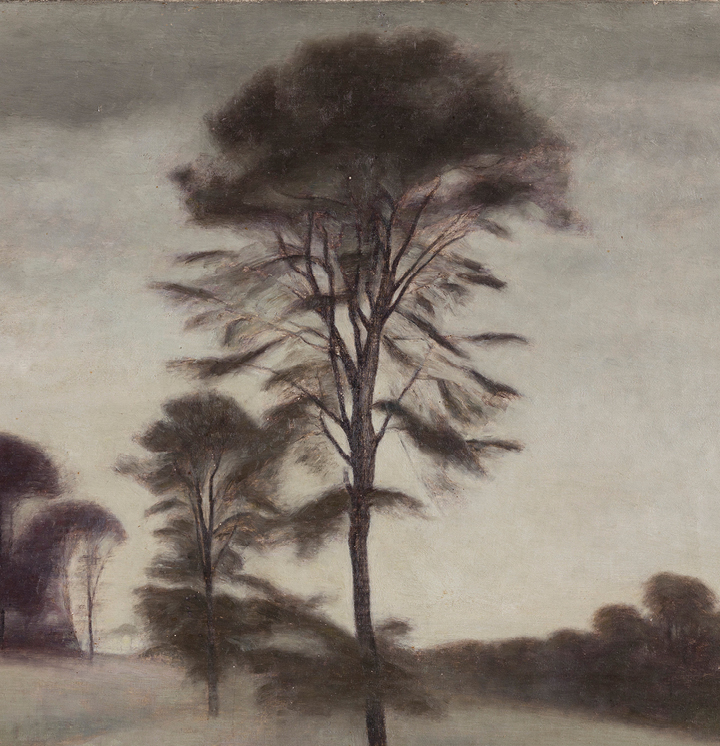ORDRUPGAARD ACQUIRES TWO NEW PAINTINGS BY VILHELM HAMMERSHØ
Two early and very rare motifs have now been added to Ordrupgaard’s already extensive collection of works by
Vilhelm Hammershøi (1864–1916): Landscape. Summer.
’Ryet’, 1896, acquired by the museum at Christie’s in London with financial support from the foundations Augustinus Fonden, the New Carlsberg Foundation, and Aage og Johanne Louis-Hansens Fond, and The Red Room, ca 1897, recently deposited at the museum by a private lender. With a total of twenty-one paintings, Ordrupgaard houses a uniquely important collection by this enigmatic painter, who worked with a few selected motifs, typically held in shades of grey. The collection comprises all the genres practised by the artist: the iconic interiors, architecture and landscape paintings, and portraits of close family members. The addition of two new works serves to significantly enhance the collection, shedding light on new facets of the artist’s practice.
Gertrud Oelsner, director at Ordrupgaard, says, ’We are extremely grateful – thanks to generous financial support from Augustinus Fonden, the New Carlsberg Foundation, and Aage og Johanne Louis Hansens Fond – that we
managed to secure Landscape. Summer. ‘Ryet’ from 1896. Together with the deposit of The Red Room from ca 1897, the museum can now present a total of twenty-one of the very best of Hammershøi’s works. Ordrupgaard and Hammershøi are closely intertwined, a tradition traced back to the time of the founders of the museum. In the future, Hammershøi will continue to be in focus with an upcoming new hanging of works entitled Home of Hammershøi, plus international collaborative exhibition projects and a major exhibition of Hammershøi here at Ordrupgaard in 2027.’
HOMECOMING AND FIRST-EVER PRESENTATION
In the case of Landscape. Summer. ’Ryet’, 1896, the painting is returning to Ordrupgaard, as it was formerly deposited at the museum by its previous owner. The motif is from Lille Værløse, Zealand, where Hammershøi stayed in the summer of 1895. With his distinctive technique, the artist has depicted the scattered trees amid the grass almost like suspended forms with muted, semi-transparent treetops and with the trunks tracing graphic lines through the landscape. Eternity and the momentary merge in a space with a grey densely overcast sky void of sunshine. The painting is a valuable contribution to the important but, as yet, relatively untold story about the artist’s landscape paintings. Here, too, he was an innovator, and his works broke new ground within contemporary symbolist landscape painting. This is the first time, The Red Room, ca 1897, is presented in a public collection. Up to now, the painting was part of a private art collection and, quite possibly, has never been shown before. Moreover, this is an extremely rare work that shows Hammershøi to be a formidable colourist. The picture shows a sparsely furnished room in the style of Louis XVI with coral and pink wall sections and a few Hepplewhite chairs placed along the walls. The architectural lines draw the gaze towards the left corner of the room, and the motif is rendered in a wide-angled perspective, common in photography but entirely new at the time. The interior is characterised by an ethereal
airiness that goes beyond time and place, as if to captivate the spirit of the place or perhaps an inner mental state. The motif is derived from the artist
and his wife, Ida’s, very first home in the Ny Bakkehuset, Frederiksberg near Copenhagen, where the newly-wed couple settled in 1892 on returning from their honeymoon. The conspicuous pink panels from this interior are preserved at Designmuseum Danmark.
HOME OF HAMMERSHØI
The founders of Ordrupgaard, Henny and Wilhelm Hansen, were among the first to collect works by Vilhelm Hammershøi. Already in 1901, the first acquisition was made: Interior, 1901, to be followed by several important acquisitions. The museum has continued to add to the collection of the artist’s works after Hansen’s time, not least initiated by the major international exhibitions arranged by Ordrupgaard – first in 1981 and later in the 1990s, when the museum arranged temporary exhibitions about Hammershøi
at Musée d’Orsay in Paris and at the Guggenheim Museum in New York, respectively. Today, the collection of Hammershøi’s works is a veritable cornerstone of the museum collection, and it is widely acknowledged as probably the world’s best collection of the artist’s works.
NEW WORKS
Vilhelm Hammershøi, Landscape. Summer. ’Ryet’, 1896, was acquired with financial support from Augustinus Fonden, the New Carlsberg Foundation,
and Aage og Johanne Louis-Hansens Fond.
Vilhelm Hammershøi, The Red Room, ca 1897, is deposited by a private lender.
